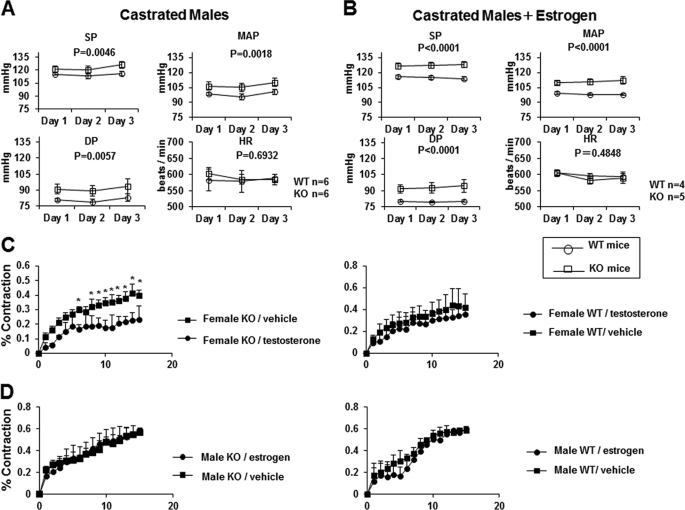FIGURE 3.
The effect of sex hormones on BP and VSMC contraction of castrated Ephb6 KO mice. A, increased BP in castrated Ephb6 KO mice. The mice were implanted with telemetry transmitters and then castrated. After 3 weeks, BP and HR were measured for 3 consecutive days. B, administration of estrogen to the castrated Ephb6 KO mice did not lower BP. Male mice were castrated 1 week after transmitter implantation; 3 weeks after the castration, the mice were administered with estrogen (240 μg) daily subcutaneously for 7 days. Their BP and HR were measured by telemetry during the last 3 days of estrogen administration. For A and B, mouse numbers per group are shown. The values are expressed as the means ± S.E. 24-h BP and HR for each day ± S.E. SP, systolic pressure; DP, diastolic pressure; MAP, mean arterial pressure. The data were analyzed by repeated analysis of variance, and the p values are shown. C, female KO VSMC showed higher contraction in the absence exogenous testosterone. VSMC from WT and KO female mice were cultured in 15% stripped FCS for 4 days in the presence of 10 μg/ml testosterone or vehicle. The cells were then stimulated with 20 μm PE. D, estrogen did not affect VSMC contraction in the absence of Ephb6. VSMC from WT and KO male mice were cultured in 15% stripped FCS for 4 days in the presence of 10 μg/ml estrogen or vehicle. The cells were then stimulated with 20 μm PE. For C and D, each point represents the mean ± S.E. of percentage contraction of 10 or more cells. All of the experiments were repeated at least twice, and data from a representative experiment are shown. *, significant differences compared with controls (p < 0.05; paired Student's t test).

